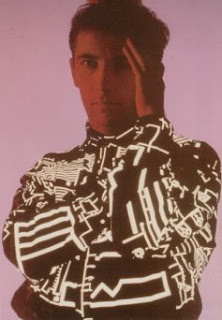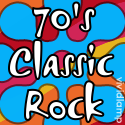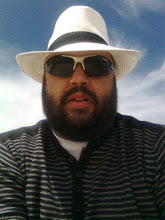 fact that it was a rather pleasant soft-rock hit from the late 70s.
fact that it was a rather pleasant soft-rock hit from the late 70s.Player (not to be confused with Player1 - see earlier post) were a pop rock quartet that formed in L.A. during 1977, and among its players were Peter Beckett (vocals/guitar), John Crowley (vocals/guitar), Ronn Moss (bass), and John Friesen (drums). Peter Beckett originally hailed from Liverpool and was a veteran on the music scene via several years playing with an outfit called Paladin. He felt the need for some sunny weather so hopped a plane over to California where he joined another band called Friends (of the non-sitcom variety), who recorded a self titled album in 1975. Friends evolved into Skyband thereafter, which likewise released a single album in 1975 (again self-titled), followed by a tour overseas prior to disbanding.
So in 1976 Beckett found himself a singer/guitarist without a band, but not without an invitation to a swanky L.A. party - the kind where lots of out of work actors and musicians try to make contact with all the right people. Apparently at this particular party all the guests were expected to wear white, but Peter Beckett wasn’t big on convention, so he rocked up wearing his favourite pair of denim jeans. To his relief he wasn’t the only rebel in jeans that night, and found a denim compatriot in John Charles Crowley III, a musician hailing from Galveston Bay in Texas. So they both wore jeans and both played music - it must be destiny that they should start a band. The pair first met up to jam a little and get a feel for the musical tastes and talents of one another. They first played together for a brief time in a band called Riff Raff, which released one single
 ‘Jukebox Saturday Night’ to little notice. The chemistry was good enough for Beckett and Crowley to agree to the idea of organising another band to play their own songs. It was L.A. and it was the mid 70s, so finding talented and available musicians willing to join a new band shouldn’t be a problem.
‘Jukebox Saturday Night’ to little notice. The chemistry was good enough for Beckett and Crowley to agree to the idea of organising another band to play their own songs. It was L.A. and it was the mid 70s, so finding talented and available musicians willing to join a new band shouldn’t be a problem.First player added to the mix was bassist Ronn Moss, who had played in L.A. groups Count Zeppelin and his Fabled Airship, and Punk Rock. Moss knew a drummer by the name of John Friesen (the two were childhood buddies), who had previously been the drummer and assistant musical producer for the Ice Follies. The initial quartet set about recording material for a debut album, and at that point were signed to the Haven Records label (with the production team of Dennis Lambert and Brian Potter). They adopted the name Player, the inspiration for which was no more interesting than taking the word ‘players’ (in reference to the cast on a television show) and removing the ‘s’. They also took a cover photo for their proposed album, but that was before the final unofficial member of the band, Wayne Cook, joined on keyboard duties (for touring purposes). The finishing touches were put on the album which was to be called, um wait for it….‘Player’ ta-dah! Sorry to get your hopes up there. With ten songs of promising soft rock in the can, Player suffered a bit of a set back when Haven Records went belly up. But Lambert and Potter weren’t going to let the project sink without a trace, so they negotiated a deal with the R.S.O. label, which just happened to be the home of the Bee Gees.
Just as well really because otherwise the great romantic soft-rock song ‘Baby Come Back’ may have been lost to world. Beckett and Crowley co-wrote the song reportedly inside of three or
 four hours. The pair took inspiration (lyrically at least) from the fact they had each recently broken up from their respective girlfriends, and it was a way of exorcising some of that angst and heartache (familiar story). They rehearsed the song with the band in Crowley’s garage during a heat wave over the summer of ‘77, and instinctively knew they had a potential hit single.
four hours. The pair took inspiration (lyrically at least) from the fact they had each recently broken up from their respective girlfriends, and it was a way of exorcising some of that angst and heartache (familiar story). They rehearsed the song with the band in Crowley’s garage during a heat wave over the summer of ‘77, and instinctively knew they had a potential hit single.With the R.S.O. distribution/marketing machine behind them, Player released ‘Baby Come Back’ as their debut single in September ‘77. The radio friendly song was soon being added to every play list across the U.S. and debuted on the Billboard Hot 100 in October ‘77. Music critics were quick to start drawing comparisons between ‘Baby Come Back’ and a lot of the other A.O.R. (adult oriented rock) songs, citing the Hall & Oates hit ‘She’s Gone’ as one. Player were also labelled as being derivative of groups like Foreigner, Steely Dan and even their R.S.O. label-mates the Bee Gees. Player themselves were unperturbed by the criticism, after all 99% of popular music is derivative to some degree. Besides, by January ‘78 ‘Baby Come Back’ had reached #1 in the U.S., spent three weeks at the summit, and went on to sell over two million copies during a seven month stint on the American charts. Incidentally the artist that Player replaced at #1 in the U.S. was none other than the Bee Gees (‘How Deep Is Your Love’). ‘Baby Come Back’ hit the Australian charts in January ‘78 and went on to a peak of #15 (UK#32).
 Whilst ‘Baby Come Back’ was still on its ascent of the U.S. charts, Player hit the road for the first time and were soon the opening act for Gino Vanelli (see future post). Over the next couple of years they toured with the likes of Heart, Kenny Loggins (see future post) and Eric Clapton. Their follow up single maintained the band’s high profile Stateside, but ‘This Time I’m In It For Love’ (US#10) didn’t make an impact elsewhere. On the strength of the two hit singles, the ‘Player’ album racked up solid sales in the U.S. (#26/OZ#47) in early ‘78, and was a solid mix of laid back soft rock, with an occasional flirtation with harder edged fare.
Whilst ‘Baby Come Back’ was still on its ascent of the U.S. charts, Player hit the road for the first time and were soon the opening act for Gino Vanelli (see future post). Over the next couple of years they toured with the likes of Heart, Kenny Loggins (see future post) and Eric Clapton. Their follow up single maintained the band’s high profile Stateside, but ‘This Time I’m In It For Love’ (US#10) didn’t make an impact elsewhere. On the strength of the two hit singles, the ‘Player’ album racked up solid sales in the U.S. (#26/OZ#47) in early ‘78, and was a solid mix of laid back soft rock, with an occasional flirtation with harder edged fare.For their sophomore album Player (now the quartet of Beckett, Moss, Crowley, Friesen) decided to ramp up the harder edged approach, and introduced more of a heavy guitar feel to some of the songs, even daring to experiment with some prog-rock material. ‘Danger Zone’ sold well enough (US#37), but didn’t manage to produce any major hits. The lead out single ‘Prisoner Of Your Love’ climbed to US#27, whilst the follow up ‘Silver Lining’ (US#62) achieved more in the way of an imitation leather lining in terms of sales. Crowley left soon after to pursue a solo career in country music.
The remaining core trio of Beckett, Moss and Friesen signed with the Casablanca label and released the album ‘Room With A View’ in 1981, with new vocalist/guitarist Miles Joseph. By now the popularity game was over for Player and the album tanked, though it did realise one
 minor hit in ‘It’s For You’ (US#46). Ronn Moss then departed and Beckett carried the Player name forward as the only founding member, along with Friesen, still involved. 1982’s album ‘Spies Of Life’ (US#152) was issued on RCA and Player managed to notch up one last hit with ‘If Looks Could Kill’ (US#48). Beckett then retired the Player brand to pursue song writing and performing as a solo artist, though he briefly played with Little River Band in the early 90s. Ronn Moss had opted for an acting career, appearing in a few minor movie roles before trying his hand at daytime television. He played the role of Ridge Forrester in the long running TV soap ‘The Bold & The Beautiful’. Moss and Beckett dusted off the Player name in 1995 and released the album ‘Lost In Reality’ (originally titled ‘Electric Shadows’) a year later, followed by occasional touring in the late 90s. Moss later released an album titled ‘I’m Your Man’ (2000) which featured a rerecorded version of ‘Baby Come Back’ and alerted many, who only knew him from his TV soap work, to the fact that he was also an accomplished musician. At time of writing Moss and Beckett are planning to resurrect Player once again.
minor hit in ‘It’s For You’ (US#46). Ronn Moss then departed and Beckett carried the Player name forward as the only founding member, along with Friesen, still involved. 1982’s album ‘Spies Of Life’ (US#152) was issued on RCA and Player managed to notch up one last hit with ‘If Looks Could Kill’ (US#48). Beckett then retired the Player brand to pursue song writing and performing as a solo artist, though he briefly played with Little River Band in the early 90s. Ronn Moss had opted for an acting career, appearing in a few minor movie roles before trying his hand at daytime television. He played the role of Ridge Forrester in the long running TV soap ‘The Bold & The Beautiful’. Moss and Beckett dusted off the Player name in 1995 and released the album ‘Lost In Reality’ (originally titled ‘Electric Shadows’) a year later, followed by occasional touring in the late 90s. Moss later released an album titled ‘I’m Your Man’ (2000) which featured a rerecorded version of ‘Baby Come Back’ and alerted many, who only knew him from his TV soap work, to the fact that he was also an accomplished musician. At time of writing Moss and Beckett are planning to resurrect Player once again.For more comprehensive coverage of all things 'Player', please check out the following cool web sites:
www.player-theband.com
www.peterbeckett-player.com
www.ronnmoss-uncovered.com

















































